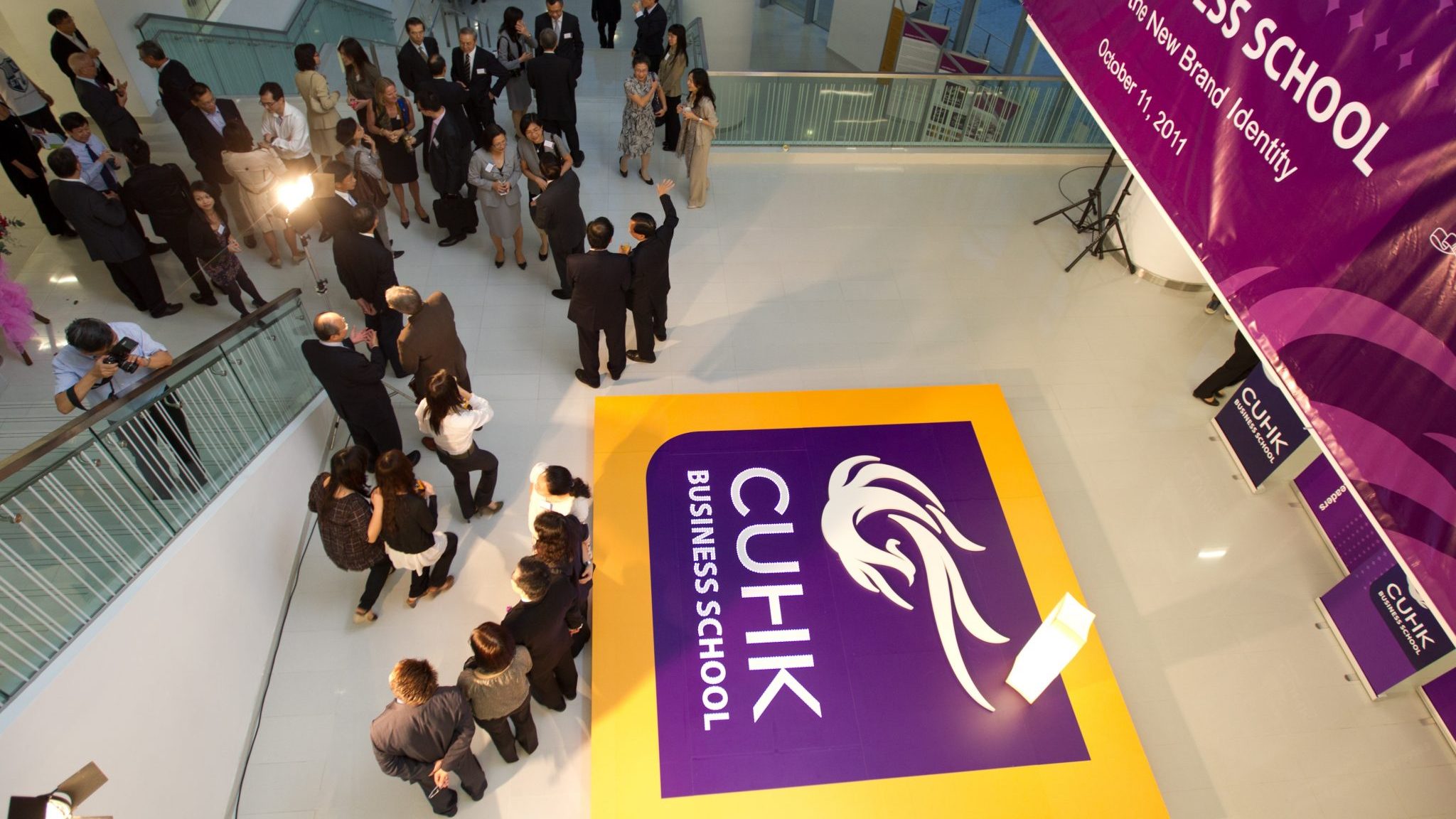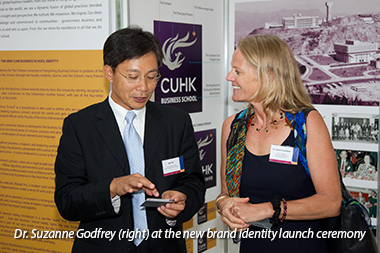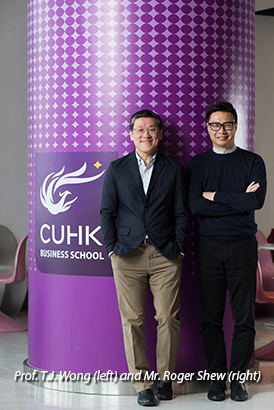Rebranding for Success: The Journey of CUHK Business School

Successful Rebranding of CUHK Business School
The leading business schools in the world all have an international profile and operate within a global environment. Competition amongst universities for the best and brightest students and staff has become increasingly fierce and the top business schools worldwide compete rigorously in this global market. As the world around us changes rapidly and constantly, top universities are required to keep moving forward and innovate in the way that they communicate their brand, core mission and values. This is precisely why the Chinese University of Hong Kong (CUHK) Business School went through a rebranding exercise and launching the new brand identity in November 2011.
Four years on, CUHK Business School recently commissioned Nielsen, an international marketing research agency, to assess the performance of its brand through a comprehensive qualitative study. According to its report, the rebranding exercise has proved to be a success in helping the School to introduce a more modern and international image, sharpening the School’s communication of its core values, strengths in teaching and research, and of its vision “To develop global business leaders for the Asian Century”.
“From the Nelson’s report, we are glad to see that our stakeholders and alumni understand and are appreciative of the School’s progress towards building a fresh image and a more dynamic global brand. However, there is still a lot more work to do, and the School remains dedicated to becoming an even more competitive and well known School at both the regional and global level,” says Roger Shew, Director of Marketing and Communications at the CUHK Business School.
The vision behind the rebrand was from the previous Dean of the Business School Prof. T.J. Wong, Choh-Ming Li Professor of Accountancy and Director of the Centre for Institutions and Governance.
“In the end, it’s all about engagement,” says Prof. Wong. “The rebranding exercise was a golden opportunity for us to engage our stakeholders. Everyone was happy with the rebranding and having a unified logo and identity. And I was very proud of our achievement.”
“In the Chinese culture, we could be a bit reserved and tend not to share about our success. But the world has moved on, we need to communicate our ideas and stories with the outside world. We need to keep telling our stakeholders including parents of our achievements and aspirations in how to prepare our students to a successful career,” says Prof. Wong.
Key Elements of the Rebrand
During the rebrand, the School underwent a significant name change. Being part of a comprehensive university with eight faculties, the School’s former name was the “Faculty of Business Administration”. In order to align itself with global practices and to communicate more clearly the core mission of the School, that is, education, the name was changed to “CUHK Business School”. Four years on and the new name is now firmly established.
“The new name representing our true identity was significant and was readily adopted by internal and external stakeholders,” recalls Shew.
CUHK Business School also introduced a new logo which takes after the symbol of University’s emblem of a phoenix, but with a modern twist and accompanied by a star-like ‘spark’ to symbolize the concept of ‘enlightenment’.
“Our logo needs to reflect our root which is deeply grounded in the University, and it also needs to convey our mission in moving onward and looking outward to the global world. The modernized phoenix is perfect in a way that it is an extension of our mother brand and to our future vision,” says Prof. Wong.
“As reflected in the Nelson’s report, the new logo was reported to be more stylish and eye-catching than the other business schools in the region” Shew adds.
Challenges of the Rebrand
As with any successful brand, the name and logo are elements which area symbolic representation of an organization, its services and products. A more comprehensive and cohesive brand identity can reflect the core values of the institution as well as create an emotional attachment with the audience. To implement the huge task of rebranding, Dr. Suzanne Godfrey, an expert with extensive experience in marketing and communication, was commissioned to be a consultant of the exercise.
“Your logo and brand identity reflects your vision and values. How you then communicate this – everything you say and do, how the brand and its people behave; is important. It also needs to be consistent to avoid ambiguity on who you are as a brand,” says Godfrey, who is an adjunct professor of the School teaching luxury branding.
As with any major change taking place in an organization, the process would be faced with some challenges, as Godfrey encountered.
“The biggest challenge was reflecting input from all the school’s stakeholders – faculty, department heads, alumni, students; and getting alignment. Finding the balance between holding on to key elements of the school’s existing brand identity yet also evolving it to something more aspirational and relevant to today and in-line with the school’s newly defined vision and mission. People naturally had slightly different opinions on this,” says Godfrey.
However, with ongoing discussions and working group meetings with the senior management and active involvement from past alumni who care deeply about the development and future of the School, what was a complex and daunting mission was finally accomplished with a launch of the rebrand in November 2011.
Selection of a compatible branding agency to help develop the new brand identity was also essential to the successes of the rebrand. The School’s excellent collaborative relationship with Hong Kong based agency Brand Image paved a robust and visually attractive and functional brand platform.
Making it all Work
The setting up of a new Marketing and Communication Office shortly after the launch of the rebrand was crucial towards establishing and consolidating the new brand identity. The Office continues to play an important role to ensure that the brand platform is implemented consistently and appropriately by internal staff and external design agencies.
“The early adoption by staff, of the principles outlined in the brand guideline was a key towards this success. In the first six months after launch, we listened closely to staff to ensure that remedial fixes to the brand platform were being addressed and that our staff had all the necessary tools and files and support to execute the rebrand with minimal disruption,” recalls Shew.
The Office has also been focused to support the School’s media outreach by helping the School’s professors and senior administrative staff to engage and connect with local and overseas media. As a result, media exposure for the School has grown significantly, including a four-fold increase in media coverage in international tier one publications over the past four years. As a result, more and more professors are interested to engage with media to share their research and expert knowledge on hot media topics every year.
To connect with the changing business environment and fast growing development in mainland China, the School has been publishing its China related research articles on an online digital platform called China Business Knowledge (CBK).
“CBK features our competitive edge in all the China-related research conducted at CUHK Business School. It is a global gateway for anyone who’s interested in cutting edge research, understanding more about the business environment in the mainland and getting useful advice on doing business in China” says Shew. “It’s also a platform to share successful stories of our alumni and the ongoing research by our PhD students – all written for the lay person” he adds.
Looking Ahead
As a result of the evolution and fine-tuning of the brand identity since the launch in 2011, a second edition of the brand guidelines will soon be released. Drawing on the experiences and developments of the past four years, the School will continue its journal towards defining and establishing a strong global brand and presence.
The School will also look to further draw upon digital and social media platforms to enhance the communication of its brand. An interactive two way communication will continue to lead the way of the future.
“I hope we could engage the public in a more interactive way, especially the young generation of our students through various social platforms. Our students are our future,” says Prof. Wong.
Under the leadership of the current Dean Professor Kalok Chan, the School will continue to benchmark itself with the leading business schools both in the region and the world, and achieve more.
“We will also look to further increase our global presence through the establishment of additional meaningful international partnerships in teaching, research and program delivery. We aim to enhance the diversity of our students population. In becoming a business school of international repute, the communication and promotion of our brand values must ultimately reflect what we are actually doing and practicing on a daily basis,” says Prof. Chan.
By Mabel Sieh



